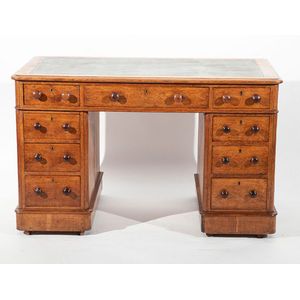Victorian Oak Kneehole Desk with 9 Drawers
You must be a subscriber, and be logged in to view price and dealer details.
Subscribe Now to view actual auction price for this item
When you subscribe, you have the option of setting the currency in which to display prices to $Au, $US, $NZ or Stg.
- Kneehole - A recessed section, mainly found on Georgian desks and dressing tables, which does not go through the full depth of the item, and usually terminates in a cupboard at the back.
- Frieze - An architectural term denoting the flat, shaped or convex horizontal surface of furniture, between the architrave and the cornice, usually found on a cabinet or bookcase, or on desks and tables where it may include drawers, the area between the top and the legs. In ceramics, the term refers to the banding, of usually a repeating pattern, on the rims of plates and vases.
- Victorian Period - The Victorian period of furniture and decorative arts design covers the reign of Queen Victoria from 1837 to 1901. There was not one dominant style of furniture in the Victorian period. Designers used and modified many historical styles such as Gothic, Tudor, Elizabethan, English Rococo, Neoclassical and others, although use of some styles, such as English Rococo and Gothic tended to dominate the furniture manufacture of the period.
The Victorian period was preceded by the Regency and William IV periods, and followed by the Edwardian period, named for Edward VII (1841 ? 1910) who was King of the United Kingdom and the British Dominions and Emperor of India for the brief period from 1901 until his death in 1910. - Oak - Native to Europe and England, oak has been used for joinery, furniture and building since the beginning of the medieval civilisation. It is a pale yellow in colour when freshly cut and darkens with age to a mid brown colour.
Oak as a furniture timber was superceded by walnut in the 17th century, and in the 18th century by mahogany,
Semi-fossilised bog oak is black in colour, and is found in peat bogs where the trees have fallen and been preserved from decay by the bog. It is used for jewellery and small carved trinkets.
Pollard oak is taken from an oak that has been regularly pollarded, that is the upper branches have been removed at the top of the trunk, result that new branches would appear, and over time the top would become ball-like. . When harvested and sawn, the timber displays a continuous surface of knotty circles. The timber was scarce and expensive and was used in more expensive pieces of furniture in the Regency and Victorian periods.
This item has been included into following indexes:
- desks, period or age - Victorian 420
-
desks, style or type
- kneehole 49
- small antique pedestal 184
Visually similar items

Nathan Buckley: Signed Collingwood jumper, window mounted with replica Brownlow Medal & three photographs, framed & glazed, overall 81 x 109 cm. With CoA

Set of 6 19th century mahogany Trafalgar dining chairs with carved mid bar & matching carver chair with scrolled arms

A Victorian sterling silver partial fluted coffee pot by William & John Barnard, London 1880, engraved with a ducal crest. 21 cm high, 650 grams. Provenance: The Collection of Sir Tristan and Lady Antico. Christie?s, 17 April 1975, lot 50

Lapis lazuli necklace, with 9ct gold clasp, length 44 cm
